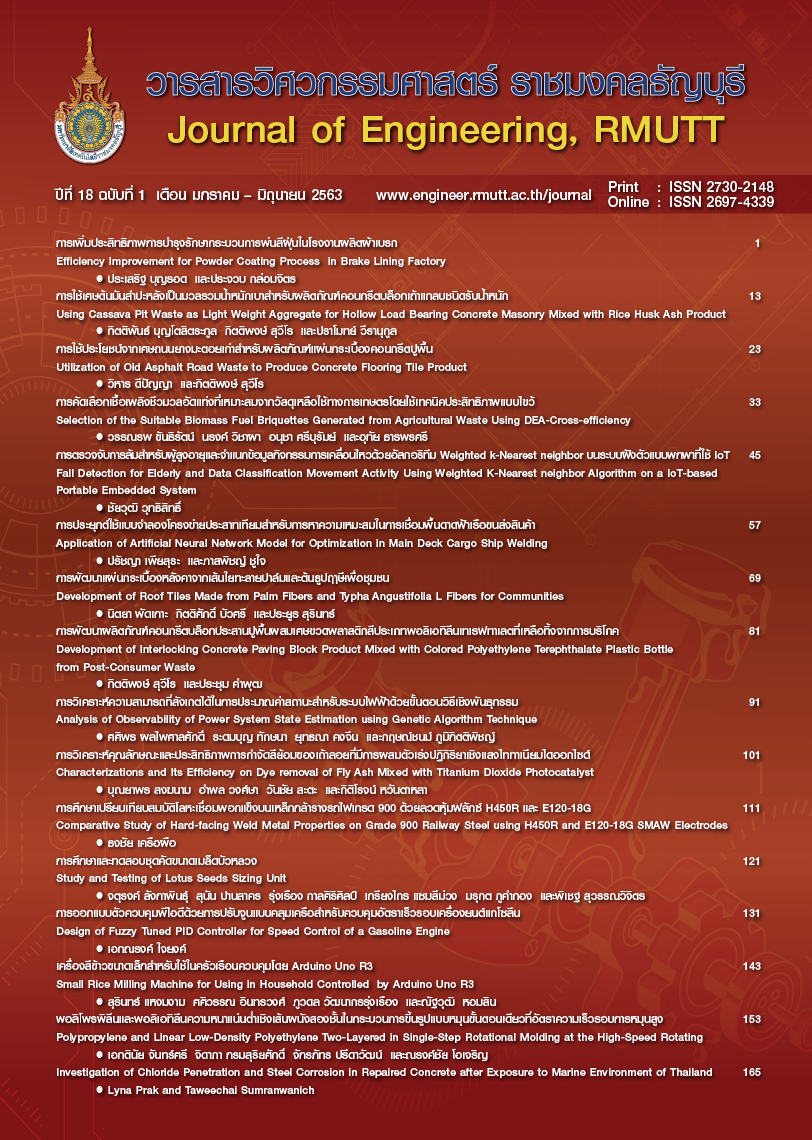การคัดเลือกเชื้อเพลิงชีวมวลอัดแท่งที่เหมาะสมจากวัสดุเหลือใช้ทางการเกษตรโดยใช้เทคนิคประสิทธิภาพแบบไขว้
Main Article Content
บทคัดย่อ
แนวคิดในการนำวัสดุเหลือใช้ทางการเกษตรมาแปรรูปเป็นเชื้อเพลิงอัดแท่งเป็นหัวข้อที่น่าสนใจ อย่างไรก็ตามถ่านอัดแท่งแต่ละชนิดควรถูกพิจารณาคุณสมบัติที่เกี่ยวข้องหลายอย่างพร้อม ๆ กัน โดยในงานวิจัยนี้ถ่านอัดแท่งจากวัสดุทางการเกษตรจำนวน 7 ชนิด ได้ถูกประเมินประสิทธิภาพและเรียงลำดับความสำคัญ ลำดับแรกถ่านอัดแท่งแต่ละชนิดวัสดุจะถูกนำไปทดสอบคุณสมบัติที่สำคัญ ได้แก่ ค่าความร้อน ปริมาณคาร์บอนคงตัว ปริมาณความชื้น และปริมาณเถ้า หลังจากนั้นการวิเคราะห์การล้อมกรอบข้อมูล (Data Envelopment Analysis; DEA) จะถูกใช้สำหรับคำนวณประสิทธิภาพของแต่ละวัสดุ สุดท้ายถ่านอัดแท่งแต่ละชนิดจะถูกประเมินความสำคัญโดยใช้เทคนิคประสิทธิภาพแบบไขว้ (DEA Cross -efficiency) ผลการศึกษาพบว่าขี้เลื่อย และกะลามะพร้าว เป็นพลังงานทางเลือกที่มีประสิทธิภาพ (ค่าคะแนนประสิทธิภาพเท่ากับ 1) โดยเรียงลำดับความสำคัญได้ดังนี้ กะลามะพร้าว ขี้เลื่อย กากอ้อย กกธูปฤาษี แกลบ ไมยราบ และ ผักตบชวา ตามลำดับ
Article Details
บทความ ข้อมูล เนื้อหา รูปภาพ ฯลฯ ที่ได้รับการตีพิมพ์ในวารสารแนวหน้าวิจัยนวัตกรรมทางวิศวกรรม ถือเป็นลิขสิทธิ์ของวารสารฯ เท่านั้น ไม่อนุญาติให้บุคคลหรือหน่วยงานใดคัดลอกเนื้อหาทั้งหมดหรือส่วนหนึ่งส่วนใดไปเผยแพร่เพื่อกระทำการใด ๆ ที่ไม่ถูกต้องตามหลักจริยธรรม
เอกสารอ้างอิง
Department of Alternative Energy Development and Efficiency. Energy situation in Thailand 2018 [internet]. [cited 2018 Mar 26]. Available from: http://www.dede.go.th/download/state_61/Frontpagejan_nov60. (In Thai)
Tantisattayakul T, Phongkasem S, Phooyar P, Taibangury P. Community-based renewable energy from biomass briquettes fuel from coconut leaf. Thai Science and Technology Journal. 2015;23 (3): 418-31. (In Thai)
Department of Alternative Energy Development and Efficiency. The potential of biomass materials in Thailand 2018 [internet].[cited 2018 Mar 26]. Available from:http://www.dede.go.th/dede/index.php?option=com_content&view=article&id=130:2010-05-07-08-10-57&catid=58&Itemid=68. (In Thai)
Wongsaroj K, Sawadsev T, Prathinthong N,Wongsrivej P. Biomass briquette production from Jatropha. KKU Engineering Journal.2011; 38 (1): 65-72. (In Thai)
Kitipattaworn A, Reubroycharoen P,Uttamaprakorm W. Briquette fuel from co-production of ethanol industrial wet cake and biomass. Journal of Energy Research. 2013; 10 (3): 43-56. (In
Thai)
Wattanachira L, Laapan N, Chatchavarn V,Thanyacharoen A. Development of biobriquettes from mixed rice-straw and longan waste residues. KMUTT Research and Development Journal. 2016; 39(2): 239 – 54. (In Thai)
Punin W. Development of briquette fuel from co-production of corn cob charcoal and low-grade coal lignite rejects.Burapha Science Journal. 2018; 23 (1):146 – 63. (In Thai)
Kumar A, Sah B, Singh AR., Denga Y, He X,Kumar P, Bansal R.C. A review of multicriteria decision making (MCDM) towards sustainable renewable energy development.Renewable and Sustainable Energy Reviews. 2017; 69 (1): 596–609.
Liberatore MJ, Nydick RL. The analytic hierarchy process in medical and health care decision making: a literature review. European Journal of Operational Research. 2008; 189 (1): 194–207.
Kittiyakajon M. Learning resources improvement project prioritization: an application of analytic hierarchy process method.Journal of Engineering, RMUTT. 2019; 17(1): 25–9. (In Thai)
Bilbao-Terol A, Arenas-Parra M, Cañal Fernández V, Antomil-Ibias J. Using TOPSIS for assessing the sustainability of government bond funds. Omega.2014; 49 (1): 1 – 17.
Wichapa N, Khokhajaikiat P. A hybrid multicriteria analysis model for solving the facility location–allocation problem:a case study of infectious waste disposal. Journal of Engineering and Technological Sciences. 2018; 50 (5):698-718.
Wichapa N, Chumpol A, Sudsuansee T.Using the hybrid DEA-TOPSIS technique for selecting the suitable biomass materials for processing into fuel briquettes. The Journal of Industrial Technology. 2019; 15 (1): 63-80. (InThai)
Charnes A, Cooper WW, Rhodes E.Measuring the efficiency of decision making units. European Journal of Operational Research. 1978; 2 (6): 429-44.
Karasakal E, Aker P. A multi-criteria sorting approach based on data envelopment analysis for R&D project selection problem. Omega. 2017; 73 (1): 79-92.
Falagario M, Sciancalepore F, Costantino N, Pietroforte R. Using a DEA-cross efficiency approach in public procurement tenders. European Journal of Operational Research. 2012; 218 (2): 523-29.
Lim S, Oh KW, Zhu J. Use of DEA crossefficiency evaluation in portfolio selection: an application to Korean stock market. European Journal of Operational Research. 2014; 236 (1):361-68.
Liu X, Chu J, Yin P, Sun J. DEA crossefficiency evaluation considering undesirable output and ranking priority: a case study of eco-efficiency analysis of coal-fired power plants. Journal of Cleaner
Production. 2017; 142 (2): 877-85.
Farrell, MJ. The measurement of productive efficiency. Journal of the Royal Statistical Society. 1957; 120(3): 253-90.
Khushalani J, and Ozcan YA. Are hospitals producing quality care efficiently? An analysis using dynamic network data Envelopment analysis (DEA). Socio-Economic Planning Sciences. 2017;60(1): 15-23.
Ennen D, Batool I. Airport efficiency in Pakistan - a data envelopment analysis with weight restrictions. Journal of Air Transport Management. 2018; 69 (1):205-12.
Fazlollahi A, Franke U. Measuring the impact of enterprise integration on firm performance using data envelopment analysis. International Journal of Production Economics. 2018; 200 (1):119-29.
Farahani RZ, SteadieSeifi M, Asgari N.Review article multiple criteria facility location problems: a survey. Applied Mathematical Modelling. 2010; 34 (1):1689-709.
Wichapa N, Khokhajaikiat P. Selection of the best laptop for educational purposes using hybrid decision making technique. RMTSV Research Journal.2018; 10 (3): 368-84.
Fan Y, Bai B, Qiao Q, Kang P, Zhang Y,Guo J. Study on eco-efficiency of industrial parks in China based on data envelopment analysis. Journal of Environmental Management. 2017;192(1): 107-15.
Wang CN, Nguyen XT, Wang YH. Automobile industry strategic alliance partner selection: the application of a hybrid DEA and Grey theory model. Sustainability.2016; 8 (2): 1-18.
Ang S, Chen M, Yang F. Group crossefficiency evaluation in data envelopment analysis: an application to Taiwan hotels. Computers & Industrial Engineering.2018; 125 (1): 190-99.
Wang YM, Chin KS, Lou Y. Cross-efficiency evaluation based on ideal and antiideal decision making units. Expert Systems with Applications. 2011; 38 (8):10312-10319.
Phutteesakul RR, Suwakantakul A, Kucharrat A. The Production of charcoal briquette by coconut shell and cassava rhizome.Journal of Industrial Education. 2010;4(2): 18-28. (In Thai)
Chutsawang N. Charcoal briquette from durian husk in Tombol Kwuanhuk community enterprise, Khlung, Chanthaburi [Dissertation of Master of Engineering in Engineering Management]. Chanthaburi:Rambhai Barni Rajabhat University;2013. (In Thai)
Jolanun B, Phutharukchat A, Khamtui C.Community-based renewable energy from mimosa pigra L. charcoal briquettes.KKU Research Journal. 2011; 16 (1):20-31. (In Thai)
Doyle J, Green R. Data envelopment analysis and multiple criteria decision making. Omega.1993; 21(6): 713-15.
Department of Industrial Works. The manual of guidelines and criteria for processing into fuel briquettes and interlocking blocks [internet]. [cited 2019 Oct 1]. Available from: http://webintra.diw.go.th/iwmb/form/iwd040_%E0%B8%9C%E0%B8%99%E0%B8%A7%E0%B8%81%20%E0%B8%87_%E0%B8%84%E0%B8%B9%E0%B9%88%E0%B8%A1%E0%B8%B7%E0%B8%AD%E0%B8%99%E0%B8%B3%E0%B8%A3%E0%B9%88%E0%B8%AD%E0%B8%87. (In Thai)
Thailand Institute of Scientific and Technological Research. Analysis of biomass properties [internet]. [cited 2019 Oct 1] Available from: http://www.charcoal.snmcenter.com/charcoalthai/hot.php. (In Thai)


